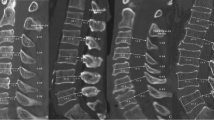Abstract
Purpose
Congenital cervical stenosis (CCS) occurs when the bony anatomy of the cervical canal is smaller than expected in the general population predisposing an individual to symptomatic neural compression. No studies have defined CCS based on the normal population. The diagnosis is currently made based on clinical impression from radiographic studies. The aim of this study is to establish parameters that are associated with CCS, based on anatomic measurements on a large sample of skeletal specimens.
Methods
From the Hamann-Todd collection at the Cleveland Museum of Natural History, 1,066 skeletal specimens were selected. Digital calipers were used to measure the sagittal canal diameter (SCD), interpedicular distance (IPD), and pedicle length. Canal area at each level was calculated using a geometric formula. A standard distribution was created and values that were 2 SD below mean were considered as congenitally stenotic. An analysis of deviance was performed to identify parameters that were associated with CCS. Regression analysis was used to determine odds ratios (OR) for CCS using these parameters.
Results
CCS was defined at each level as: C3/4 = 1.82 cm2, C4/5 = 1.80 cm2, C5/6 = 1.84 cm2, C6/7 = 1.89 cm2, C7/T1 = 1.88 cm2. Values of SCD < 13 mm and IPD < 22.5 mm were associated with CCS and yielded sensitivities and specificities of 88–100 % at each level. Logistic regression demonstrated a significant association between these parameters and presence of CCS with OR > 18 at each level.
Conclusions
Based on our study of a large population of adult skeletal specimens, we have defined CCS at each level. Values of SCD < 13 mm and IPD < 23 mm are strongly associated with the presence of CCS at all levels.




Similar content being viewed by others
References
Gowers WR (1892) Disease of the nervous system, vol 1, 2nd edn. Churchill, London
Kalichman L, Cole R, Kim DH, Li L, Suri P, Guermazi A (2009) Spinal stenosis prevalence and association with symptoms: the Framingham Study. Spine J 9(7):545–550
Shedid D, Benzel EC (2007) Cervical spondylosis anatomy: pathophysiology and biomechanics. Neurosurgery 60(1 Supp1 1):S7–S13
Macalister A (1894) The development and varieties of the second cervical vertebra. J Anat Physiol 28:257–268
Cyriax EF (1920) On certain absolute and relative measurements of human vertebrae. J Anat 54(Pt 4):305–308
Francis CC (1955) Dimensions of the cervical vertebrae. Anat Rec 122(4):603–609
Payne EE, Spillane JD (1957) The cervical spine: an anatomico-pathological study of 70 specimens with particular reference to the problem of cervical spondylosis. Brain 80(4):571–596
Gupta SK, Roy RC, Srivastava A (1982) Sagittal diameter of the cervical canal in normal Indian adults. Clin Radiol 33(b):681–685
Kang JD, Figgie MP, Bohlman HH (1994) Sagittal measurements of the cervical spine in subaxial fractures and dislocations: an analysis of two hundred and eighty-eight patients with and without neurological deficits. J Bone Joint Surg Am 76(11):1617–1628
Kim KY, Song B (1975) Radiological measurements of cervical spinal canal in normal Korean adults. J Kor Neurosurg Soc 4(2):239–246
Kothari P, Freeman B, Grevitt M, Kerslake R (2000) Injury to the spinal cord without radiological abnormality (SCIWORA) in adults. J Bone Joint Surg Br 82(7):1034–1037
Chabot MC, Montgomery DM (1995) The pathophysiology of axial and radicular neck pain. Semin Spine Surg 7:2–8
Kumaresan S, Yoganandan N, Pintar FA, Maiman DJ, Goel VK (2001) Contribution of disc degeneration to osteophyte formation in the cervical spine: a biomechanical investigation. J Orthop Res 19(5):977–984
Bernhardt M, Hynes RA, Blume HW, White AA (1993) Cervical spondylotic myelopathy. Bone Joint Surg Am 75(1):119–128
Vara CS, Thompson GH (2006) A cadaveric examination of pediatric cervical pedicle morphology. Spine 31(10):1107–1112
Krejcie RV, Morgan DW (1970) Determining sample size for research activities. Educ Psychol Measur 30:607–610
Lee HM, Kim NH, Kim HJ, Chung IH (1994) Mid-sagittal canal diameter and vertebral body/canal ratio of the cervical spine in Koreans. Yonsei Med J 35(4):446–452
Hashimoto I, Tak YK (1977) The true sagittal diameter of the cervical spinal canal and its diagnostic significance in cervical myelopathy. J Neurosurg 47(6):912–916
Tatarek NE (2005) Variation in the human cervical neural canal. Spine J 5(6):623–631
Inoue H, Ohmori K, Takatsu T, Teramoto T, Ishida Y, Suzuki K (1996) Morphological analysis of the cervical spinal canal, dural tube and spinal cord in normal individuals using CT myelography. Neuroradiology 38(2):148–151
Debois V, Herz R, Berghmans D, Hermans B, Herregodts P (1999) Soft cervical disc herniation: influence of cervical spinal canal measurements on development of neurologic symptoms. Spine 24(19):1996–2002
Matsuura P, Waters RL, Adkins RH, Rothman S, Gurbani N, Sie I (1989) Comparison of computerized tomography parameters of the cervical spine in normal control subjects and spinal cord-injured patients. J Bone Joint Surg Am 71(2):183–188
Lee MJ, Cassinelli EH, Riew KD (2007) Prevalence of cervical spine stenosis: anatomic study in cadavers. J Bone Joint Surg Am 89(2):376–380
Higo M (1987) Roentgenological study of antero-posterior diameter in developmental canal stenosis of cervical spine. Nihon Seikeigeka Gakkai Zasshi 61(5):455–465
Sasaki T, Kadoya S, Iizuka H (1998) Roentgenological study of the sagittal diameter of the cervical spinal canal in normal adult Japanese. Neurol Med Chir (Tokyo) 38(2):83–88 discussion 88-9
Bente L, Gerrior SA (2002) Selected food highlights of the 20th century: US food supply series. Fam Econ Nutr Rev 14:43–52
Conflict of interest
None.
Author information
Authors and Affiliations
Corresponding author
Rights and permissions
About this article
Cite this article
Bajwa, N.S., Toy, J.O., Young, E.Y. et al. Establishment of parameters for congenital stenosis of the cervical spine: an anatomic descriptive analysis of 1066 cadaveric specimens. Eur Spine J 21, 2467–2474 (2012). https://doi.org/10.1007/s00586-012-2437-2
Received:
Revised:
Accepted:
Published:
Issue Date:
DOI: https://doi.org/10.1007/s00586-012-2437-2




